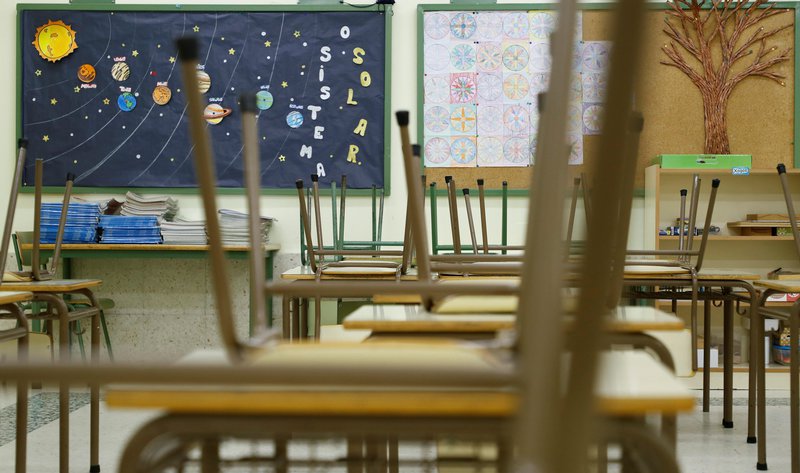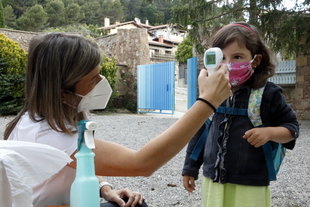The world goes back to school
On September 14, face-to-face classes return to schools amid government assurances that classrooms are safe and families’ fears that they will become a hotbed of contagion for children. This will be no normal, or easy, school year
This will not be a normal school year for anyone. Schools reopen for the first time in six months due to the Covid-19 pandemic and with reasonable doubts over whether the security and protection measures widely announced by the government will be sufficient for students to continue attending classes with some normality until the month of June. The virus has turned the educational structure on its head and highlighted even more that a system historically lacking in resources is now forced to work under the threat of becoming a new source of infection. Added to the fears of families and professionals are complaints of an insufficient and delayed response with unpredictable consequences. The decision to keep face-to-face classes, in a clear commitment to guaranteeing the universal right to education and preventing the social gap from widening, is proving a huge challenge.
The same doubts are of course also afflicting other countries, whether their pupils have returned to the classroom or not. The World Health Organisation (WHO) itself has warned that returning to school can only be considered safe if done in a context where local coronavirus transmission is low. “If transmission is low in the community, if epidemiological surveillance, contact tracking and health care are good, then schools can reopen,” said Mike Ryan, director of the WHO Department of Health Emergencies.
Schools have begun to reopen in some European countries, and the school year will be fully resumed on this continent and in North America in the coming weeks, which has triggered health alarms, especially after a study conducted in two Massachusetts hospitals revealed that children may be “hidden carriers” of the coronavirus and spread it more than previously thought.
Here we compare how other countries are dealing with the return to school, compared to the 10 measures that have been announced for Catalonia (listed above right).
France
Will masks be the lifeline for a normal return to school? This is what the French government thinks. Some 12.8 million children and adolescents return to schools in France with many of the social distancing measures applied in May relaxed on the one hand but with compulsory use of masks on the other. The use of masks will be mandatory for all teachers and students over the age of 11. It is a lower requirement than the WHO’s proposal to use masks from the age of six, but it expands their use compared to the return to the classrooms during lockdown. At the time, secondary school students and teachers were only required to protect their faces in schools where safety distances of one metre could not be respected. Minors account for less than 5% of the number of Covid cases and do not usually show severe symptoms. In France, however, there has been a significant increase in infections in recent weeks, mostly between the ages of 15 and 44, a range that includes secondary school students.
Germany
Germany has returned to school in separate waves, in accordance with to its federal system. With or without a pandemic, school years and holidays do not begin or end on the same day, not even the same month. Each Land has its own weeks between the end of June and beginning of September, a practice aimed at preventing the population from all going on holiday at once in the EU’s most heavily populated country.
As for special measures against Covid-19, the rule of leaving everything under the jurisdiction of each regional power has remained in place. The school year began in Berlin on July 10, with masks compulsory in schools’ communal areas. North Rhine-Westphalia, the most populous state with 18 million people, and the most affected by the pandemic, did so a week later, with masks also compulsory in classrooms.
The first children to return to school were from Mecklenburg-Vorpommern, a rural Land with the country’s lowest incidence of infection. Yet, two schools had to close a day after the re-start. Bavaria, with the second highest contagion rate, will be the last to return to class and will have been able to fine-tune its social distancing measures with masks, hand washing, and so on.
Germany has experienced a continued rise in infections since mid-July, mostly imported by those returning from holiday. The trend is likely to continue at least until the holiday season is over.
UK
Scottish schools were the first to open in the UK on August 11, and are therefore the benchmark for the country. The return to class was done in a staggered manner over one week. According to Scottish government guidelines, primary and secondary school students are not required to keep a safe distance and masks are voluntary for both pupils and teachers.
Schools have remodelled the layout of the spaces with entrance and exit doors only. There is a limit on the number of students walking around the building at one time. Inside, each classroom has its own disinfection point and has been equipped with gel and cleaning products for students to clean desks and chairs each time they use them.
All desks face the board. Children sit in pairs and remain companions throughout the year so as to mix as little as possible. This is how they have created what they have defined as “bubble classes” to limit contact.
British PM Boris Johnson has declared school reopening a priority and attendance mandatory, despite some parents’ reluctance. Schools in England open this week. The use of masks is recommended in secondary school and will be mandatory in districts with high infection levels.
Belgium
The Belgian government announced that all students would start school on September 1 with masks obligatory for those over 12, and that there would be no excursions “until further notice”. The Belgian plan currently focuses on secondary school students, although an additional document is expected with guidance for the younger ones.
The measures in this country are based on the observation of the partial return to classes in May and June, in which no rise in the spread of the virus was detected. The government expects students to go to school five days a week, after ruling out distance learning on Wednesdays as originally planned.
Scandinavia
While Denmark and Norway are committed to normal education, Finland has retained restrictions and warns of new measures, and in Sweden, which did not close schools during the pandemic, it is unknown whether children will return to face-to-face teaching in secondary schools after the holidays. Masks are not required at schools in these countries, although they are being used on public transport this month.
education




